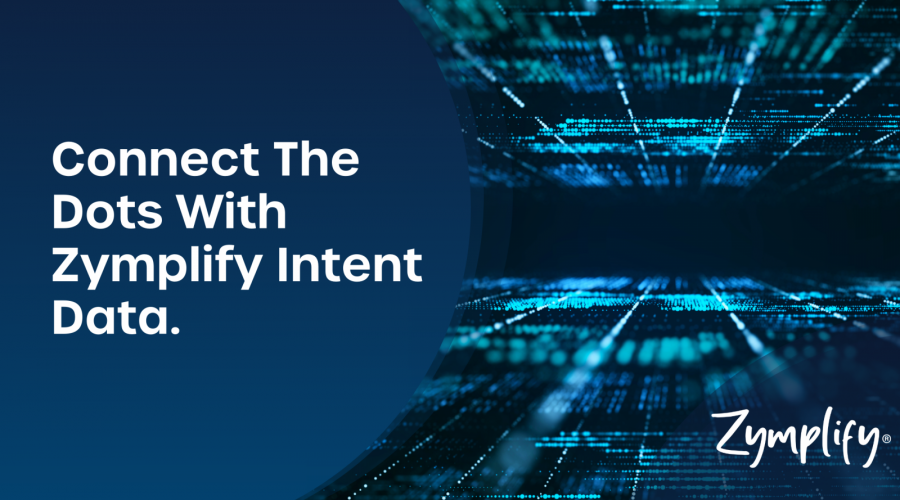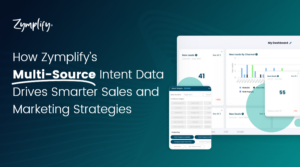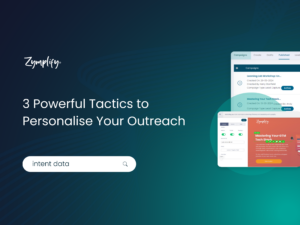What exactly are first and third-party buyer intent data? Zymplify provides both, so how do marketing and sales teams action the data insights they get from Zymplify intent data sources?
FIRST PARTY INTENT DATA
First-party intent data is data gained from a direct (first-party) engagement of a prospect/person directly on your OWN digital assets such as the company website, website forms, pop-ups, email opens and clicks, or bespoke landing pages. These engagements are captured on Zymplify; it tracks, monitors, and then provides reporting data directly to the Zymplify Dashboard.
Example of a first-party intent engagement use case in Zymplify
• A prospect engages with one of the business’ digital channels, website, email, webform, and so on.
• Contact details/engagement details recorded and time stamped in Zymplify
• A detailed record of all previous and subsequent engagements is recorded against the contacts record on Zymplify, building a ‘picture’ of engagement.
• Assessment of how close the contact is to purchasing takes place (demonstrated by the value of the assets they engaged with or lead score on Zymplify). E.g., if they filled out a website form to Book A Demo, then they are bottom of the funnel, if they clicked an email download case study button, they are middle of the funnel.
• Team determines which stage of the buyer journey (or qualified) the prospect is at and how ‘hot’ the lead is.
• If the lead is deemed suitable then add to sales pipeline, begin the sales process.
How can first-party data insights be actioned by sales and marketing teams?
The insights gained from first-party data should be viewed as invaluable to sales and marketing teams.
1) First-party data shows the contact is potentially in a ‘buying’ mode and is seeking a solution to a ‘pain point’ through engagement with your business content. This information can help the sales team ‘start the conversation’
2) Examine Zymplify Campaigns results for the content your leads are converting on. Which content has been the most useful? Distribute more of this content on other channels you use for lead capture.
3) Review and research the channels your team is using to reach prospects, which channels bring in more first-party data? Is it the webform, email website booking form? Refine your tactics after measuring the best converting channels.
THIRD-PARTY INTENT DATA
Third-party Intent Data is data obtained from outside businesses’ own platforms and channels. Zymplify Third-party Intent Data uses AI and Machine Learning algorithms to learn aggregate data signals from prospects’ online searching behaviour.
In Zymplify, third party data is tracked using 4 different types of Intent Signals
• Engagement with competitors
• Engagement with Key topics online
• Companies’ growth signals (through recruitment activity)
• Engagement with online Events
How can marketing and sales teams benefit from using Zymplify 3rd party intent data?
1) Discovery – discover new, previously unknown buyers in the market that your team didn’t have on their radar previously and add them to a Zymplify automated nurturing email journey to show them your brand and solutions while they are searching for the answers to their business pain points. Put your business at the top of their buyer journey.
2) Prioritise Leads from ABM – Take advantage of intelligence provided by Intent results on your priority accounts. Identify when the accounts you have on your radar already are researching topics related to your business or competitors.
3) Create lists/segments – By analysing the data, you can create targeted lists to nurture by email journeys on Zymplify.
4) Create Content – Through analysing the data, deliver content on the topics your buyers are engaging on to try and solve their pain points. Personalise campaigns.
5) Create Targeted Ads/social – Once Intent Data has been analysed and insights gained into the topics prospects are engaging on then the team can aim Ads and social content to those topic areas and create content for ads that correspond with those topics.
6) Run Nurturing Campaigns – Start to move the prospects down the buyer funnel using your marketing campaigns.
FIRST PARTY + THIRD PARTY
How can they be used in Tandem, as part of a B2B marketing strategy?
Used together, third party and first party can give businesses’ a comprehensive buyer funnel viewpoint, giving them in market prospects at the top of the funnel and Zymplify can then be used to move buying prospects down the sales and marketing funnel until they become marketing qualified leads.
Diagram of an Intent data process using Zymplify:

Insights and benefits for the sales and marketing teams
Third-party data Spikes in topic interest can inspire content creation & new innovative marketing campaigns.
See’ the top of the funnel. The buyer ‘awareness’ phase. Combine Zymplify automation with Intent Data from Zymplify to reach buyers in the awareness phase.
Discover in-market prospects, your business was not aware of. Drive them down the funnel with automation.
Discover if your accounts are engaging with competitors. Drive ABM with Intent Data.
Read Gartner Blog here for more information on how B2B is combining ABM with Intent Data.
First-party data
A Prospect is engaging in your business content, is likely in a ‘consideration’ phase.
Act on first-party data through automation or an active sales process on Zymplify. Examine which content is converting well and assess the existing content and then tweak the content that is not converting as successfully.
If you would like to see Intent data from Zymplify in Action, then click here to book a demo with one of our Intent Data specialists.



